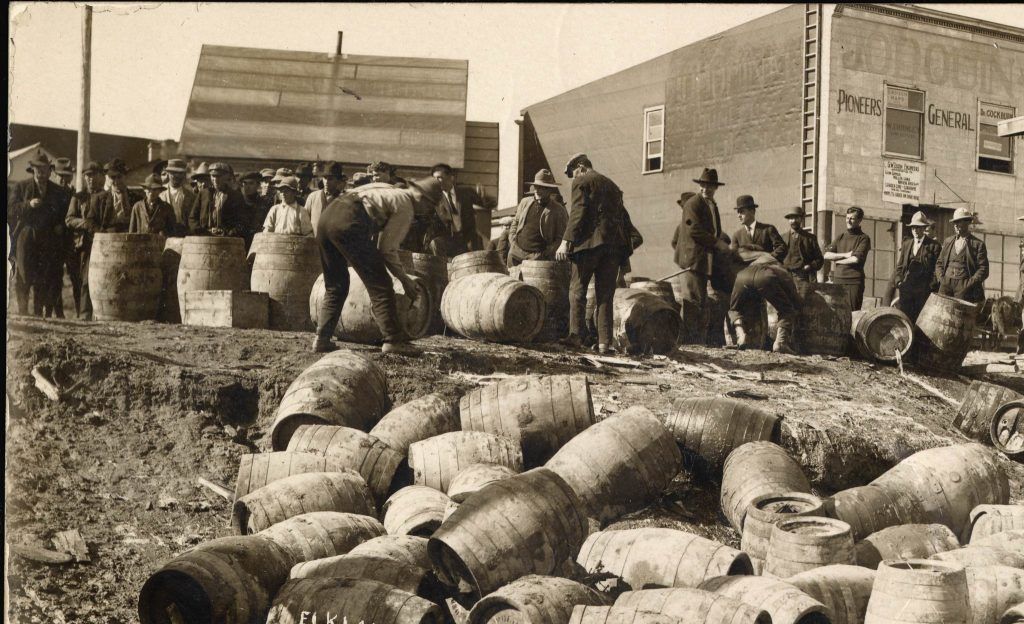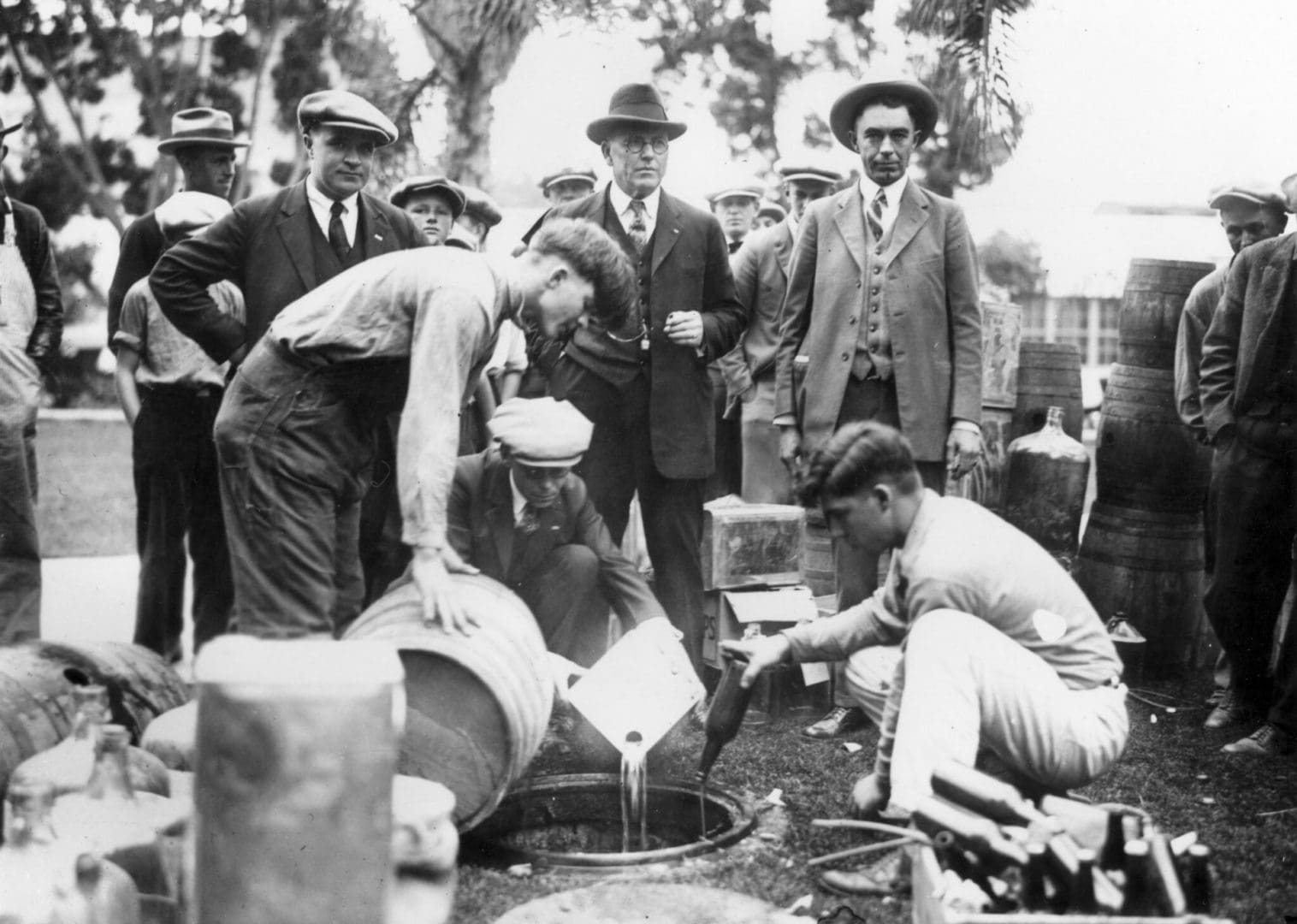To Drink Or Not To Drink
Happy birthday to you! It’s 100 years since Prohibition started in the USA – sorry I’m a little late on the anniversary, the Eighteenth Amendment was actually passed on January 17 1920, but I’ve had a killer hangover…
The US Prohibition lasted for 13 years until President Roosevelt signed off the Cullen-Harrison Act that basically legalised the drinking of beer and wine again. Now, as most people know, those intervening years allowed for both the rise of the bad; in organised crime and the good; in flappers, cocktails, jazz bands and intricate secret knock entries into illicit ‘speakeasy’ drinking establishments. The American Prohibition has also given us fantastic words like; ‘hooch’ and ‘bootlegging’ that we still use and have applied across other concepts too. Plus, Prohibition-themed work parties are always the best because they encourage us to dress up like the above, drink lots of booze and behave illicitly! How good is that? Almost justifying Prohibition itself! Especially from a safe spot far, far away over here in New Zealand.

Credit: Archives of Ontario
What most people over here don’t know however is just how close we got to having our own blanket Prohibition in New Zealand. In April 1919, a special referendum was held on the subject and Prohibition actually won once the voting was counted with an advantage of over 13,000 votes. So it looked like all the bars across the country were about to be shuttered and all those manly voices singing ancient songs of camaraderie be quieted forever…
But not so fast! World War One had only just finished and most of New Zealand’s fighting force were still either in hospital or still making their way back to Godzone. And, as they’d just proved in the ultimate way, they were still citizens of our country and deserved their vote to be counted too. And when those special votes were finally tallied up, it wasn’t good news for the Prohibitionists as the 40,000 strong soldier contingent had voted decisively for Continuance by 80% to 20%. That was enough to flip the result to a comfortable victory for the status quo by over 11,000 votes.
A narrow escape! And one that might have been impossible had the referendum been held six months earlier. It would have been an awful lot harder to gather the soldier’s votes from the front line in 1918 to say nothing of their attention being distracted by bullets, bombs and chemical weapons exploding all around them. Incensed by the closeness of the defeat, the Prohibitionists tried again during the general election in December 1919 but the die was cast and the same result was inevitable.
But, while we haven’t had a nationwide Prohibition, we have had little mini-Prohibitions or ‘dry’ areas sprinkled about the country for much of the past century or so. As ridiculous as it may seem today, there was a time when you couldn’t go to a wine or bottle shop in your suburb because the government had decided it was ‘dry’.
It all started off sensibly enough; in 1893, an act was passed which allowed individual electorates to vote on whether to control the access to liquor within their borders. The logic went thus; if successful in a referendum held every three years, the local wowsers could reduce the number of liquor outlets in their electorate, or kick them out altogether. And they were pretty successful alright with about a sixth of the country’s electorates voting to go dry – and fair enough too. If the locals didn’t want a heap of boozy fools stumbling around urinating on suburban lawns and shouting song lyrics at 3am in their streets then they had the power to stop it happening in their own back yards. Whereas the electorates with lots of commercial premises designed to accommodate boozy fools were happy to vote ‘yes’ to liquor and scoop up all those evicted alcohol-imbibers, welcoming them to a wet zone with open arms (and cash registers).
Horrified to witness such successful democracy in action without the slightest legislative interference, the government of the time immediately decided that they knew better than the general public which areas should be wet and which should be dry. What followed was decades of incomprehensible gerrymandering of alcohol-free electorates even shifting towns between wet and dry areas by decree and not allowing individual electorates to vote themselves wet or dry. Which became completely insane with the rise of the bottle store and wine shop. So you could drink at home in an electorate but may not be able to buy a bottle of alcohol from the building next door. Yet your mate in the neighbouring electorate had no such problem. A sorry state of affairs that lasted right up until 1999 when the last bastions of Drydom; Eden, Roskill and Tawa were finally able to allow bottle stores to open premises within their realms.
First World Problems? Sure, but WHERE we drink is not completely divorced from HOW we drink as you won’t need your specs to see the link between the Six O’clock Swill of pre-1967 six o’clock closing times in New Zealand pubs and our subsequent binge-drinking culture. Why wouldn’t impressionable young minds want to emulate the feats of Dad and Granddad who learned to tip beer down their throats as fast as possible standing cheek by jowl at the bar trying to beat the clock in the bad old days? Jeez, I was even a member of a Uni keg-race drinking team once!
Hopefully, we’ve moved on a little from such barbarous times as we’ve travelled more as a nation and seen how other cultures treat alcohol; like France, where even children are allowed to drink wine and Spain where you can buy sangria from the corner dairy. And if we’ve learned anything from America’s Prohibition and our own experiences with ‘wet’ and ‘dry’ areas is that we need to get the bouncer to block the government from coming into the pub. So, let’s raise a glass to Prohibition and hope we never see the likes of it again. Or if we do, then for goodness’ sakes, let’s let the individuals make their own decisions on whether they want to drink or not.
Top image: Photo courtesy Orange County Archives.

